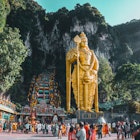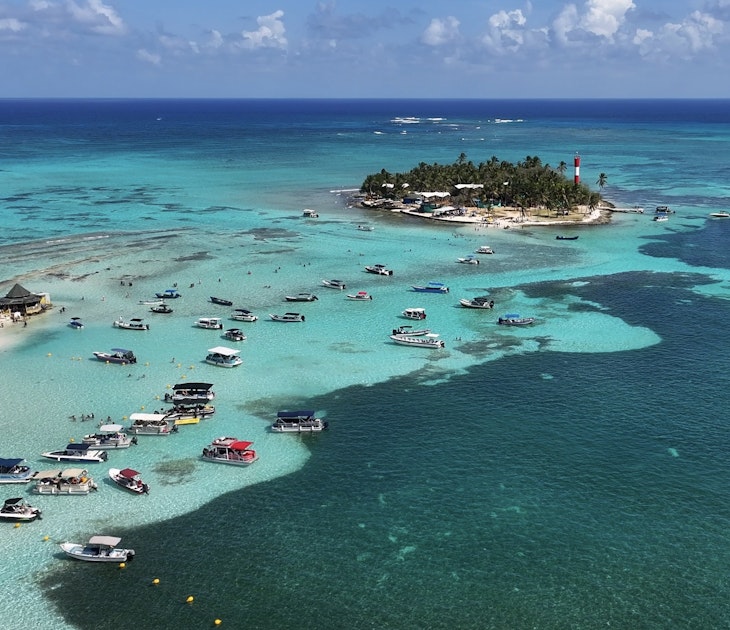

Head to quieter fishing villages like Rawai Beach for a slower paced experience of Phuket. Mongkol chai/Shutterstock
There’s much to love about Phuket besides its many powder-puff beaches. Firstly, there’s the old town, frozen in time by candy-colored mansions nodding to the days of tin barons, the proud flagship of Phuket Town.
Beyond Sino-colonial homes and palm-fringed bays await markets that are visually Thai, with pop-up stalls and motorcycle grills wherever you look. Yet foodies can also hit restaurants daily for a month and still find new dishes and eateries, such is the ethnic diversity of Phuket cuisine.
- placement: fullWidth
- path: articles/in-content-top
- possible size: [970, 250], [970, 90], [728, 90], [300, 250], [320, 50], [1, 1],
- targeting:
{ "url": "guide-to-phuket", "destination": "Phuket", "continent": "Asia", "country": "Thailand", "region": "Phuket" }
Thailand’s largest island is home to rolling hills and thick rainforests framed by gushing waterfalls, perfect for hiking adventures. Meanwhile, self-sufficient communities offer tours to tap into the emotions of the traveler.
On a cosmopolitan island like Phuket, where an estimated 70 percent of the residents have mixed Straits-born Chinese and Thai ancestral roots, you’ll find what you’re after – whether you stick to the busy areas or veer off the tried-and-tested track.
Dive into the pulse of this fascinating island and plan a memorable trip with my top tips on Phuket.
When should I go to Phuket?
Phuket knows only a dry and a wet season. If you take off for Thailand to escape the northern hemisphere winter, the time between late December and mid-April will give you a boost. February and the first half of March are the driest, with daytime highs of 36°C (95°F). Best for beach bums, conditions are sweltering during this time; lows can be as high as 28°C (82°F). However, these months are heavier on your pocket with hotel prices almost doubling.
For wallet-friendlier rates, visit in the shoulder season from late April to early June, when the crowds thin out. Weather-wise, this transitional period is hit or miss. While the rainy season starts in late June, it can be sunny for days. But heavy rains lash the island from September to mid-October, when the powerful monsoon brings moist warm air from the Indian Ocean. Stormy seas could prevent diving now, though windsurfing may be a joy, and accommodation prices plummet. Humidity levels are also lower during this time, with average temperatures of 23°C to 30°C (73°F to 86°F).
How much time should I spend in Phuket?
Plan a weekend fling with Phuket at the very least. That’s enough to lounge on a beach or two, get a massage, sample juicy, barbecued meats grilled on skewers, and check out the beer bars come nightfall. Add two more days to sip coffee and eat your way around town at a leisurely pace. To be out sightseeing and get a deeper understanding of the island’s colorful heritage, seven days will not get you bored. Over a week, you’ll have wiggle room in your schedule to go island hopping, explore evergreen national parks, or book community-based tourism activities that directly benefit locals.

Is it easy to get to and around Phuket?
Yes and no. Thai Airways has regular flights from Bangkok, as do the budget airlines. You can also hop on a bus from Bangkok to Phuket. However, Phuket’s public transportation system doesn’t compare favorably with that of the kingdom’s capital, and the island which is roughly 50km by 20km isn’t particularly suited to walking, save for the delightfully walkable old town. The Smart Bus runs every 30 to 60 minutes and will take you from the domestic airport terminal to popular west coast beaches.
The best way to crisscross the island is by Bolt, an Uber-like app that’s cheaper than Grab (or taxis for that matter). Metered taxis exist, but some drivers don’t actually like to run the meters, and can be unscrupulous hagglers. Likewise, tuk-tuks come with a price tag. On the bright side, Phuket’s four-wheeled mini-trucks have neon lights and incredible sound systems. Widely available for rent, scooters beat the stop-and-go traffic, but be aware your driver’s license from home won’t cut it: you’ll need an international driver’s license and adequate travel insurance. You can also rent a car for independence, or feel like a local on the old blue bus from Phuket Town to Patong.
Top things to do in Phuket
Go local with a Bang Rong community tour guide
A far cry from Phuket’s upmarket bars and glitzy coastal resorts, Bang Rong gives travelers an authentic taste of a self-sufficient Muslim-Thai community that still relies on fishing and agriculture. During a tour with Prasert Ritraksa, chairperson of the Bang Rong community, you can kayak into tangled mangroves, visit a local farm, and learn the ancient art of batik painting. There are also cooking workshops and other educational experiences including tapping rubber and picking coconuts.
- placement: fullWidth
- path: articles/in-content-middle
- possible size: [970, 250], [970, 90], [728, 90], [300, 250], [320, 50], [1, 1],
- targeting:
{ "url": "guide-to-phuket", "destination": "Phuket", "continent": "Asia", "country": "Thailand", "region": "Phuket" }
Embark on a private fishing trip with Phuket’s Chow Lair
Fishing with Phuket’s indigenous Chow Lair (also spelled Chao Leh/ Lae), the "people of the sea", can teach you to appreciate other cultures and lifestyles. Unlike other sea-based communities in Thailand, Phuket’s Urak Lawoi people lead settled lives on a small patch of Rawai Beach, where roosters roam. On a private fishing trip with a Phuket-born Chow Lair guide, you will experience the island’s beauty and Rawai’s seclusion – essential ingredients for these traditional communities to feel at ease.

Explore the area’s wild history
Most tourists to Phuket are blissfully unaware of the region’s turbulent history, particularly during the 19th century when indigenous tribes were displaced by Hokkien-Chinese immigrants who flocked to Phuket for the tin-mining boom. Visitors to the old town’s Chinpracha House, a Sino-Portuguese house turned museum that was Phuket’s first Ang Mor Lao, or “Red-Hair Mansion”, can admire an intriguing blend of architectural styles. Highlights include Greco-Roman columns, Victorian furniture, Italian tile floors and elaborate Chinese decorations.
Other places to learn about one of the most violent periods of Phuket’s history include, ironically, Wat Chalong. The Buddhist temple is where a monk named Luang Por Cham created a magic turban in 1876 that allegedly saved Phuket from the Chinese tin mine laborers, who attempted to burn and loot the city in a dispute over better working conditions.
For more historic architecture go to China Inn Cafe & Restaurant, notable for its red, Sino-Portuguese facade, Chinese door wings, and antique and handicraft shop. On On Hotel – made famous in the movie The Beach – is a popular heritage hotel with distinctive rectangular columns, sun-shaped patterns on whitewashed walls and a balustraded parapet.
Hike the Kata hills
Looking out over the beaches of Karon, Kata, and Kata Noi, the Kata-Karon viewpoint is just one of the highlights in the Kata hills. As it can be crowded – it’s easy to reach on the paved road halfway between Nai Harn and Kata Noi Beach – the massive granite rock of Pa Hin Dum (Black Rock) is a lesser-known alternative. You’ll find it near the Kata-Karon viewpoint after an easy, 20-minute hike up a hill on the way to Nui Beach. Peeping down grass-covered hills, Black Rock overlooks off-shore islets of southern Phuket, too, including Koh Man.
A stone’s throw from Black Rock is Laem Krating, a cracker of a cape. If you do that coming from Pa Hin Dum instead of Nai Harn Beach, you can skip the steep, 30-minute trek to Laem Krating’s horn-shaped rock. Visit just before sunset; the unbroken views of the silent ocean are particularly calming when the sun sinks orange.
My favorite thing to do in Phuket
Being based in Phuket’s Thalang area, I feel fortunate to be surrounded by local markets, one of which is virtually on my doorstep. A special place in my heart holds Talad Ruam Jai, which translates as, “the market of the joined hearts.” Every Tuesday, Thursday and Sunday, from 4:30pm to 9:00pm, lovely people sell all things Thai in front of the Lotus Mall: golden tuna spring rolls, sticky rice in bamboo tubes, spicy, tear-inducing papaya salad and bua loy (chewy rice-flour, sweet potato and pandan leaf balls bathed in homemade coconut milk) to cater to sweet tooths like me and many Thais. You get the picture… I love strolling along the market’s 90 marquee tents and catching the tantalizing scents of sticky calorie bombs that waft on the balmy evening breeze.
- placement: native
- path: articles/in-content-native
- possible size: [f, l],
- targeting:
{ "url": "guide-to-phuket", "destination": "Phuket", "continent": "Asia", "country": "Thailand", "region": "Phuket" }
Similarly, I’m keen to experience the serene vibe of Talad Nad Kondee, or “market where good people meet”. This market inside the Bangjo prison happens once a month only, and fruits like the sweet and juicy mangosteen cost a fraction of what you’d pay elsewhere. Available for a cheaper price are massages as well – all offered by prisoners about to be released.

How much money do I need in Phuket?
Phuket isn’t the cheapest place in Thailand, but you can still have a great time traveling on a budget. Just skip the beach clubs and crash in dorms, try street food and eat where the locals go. By far the most expensive area on the island is Laguna; Patong, Kata, and Karon aren’t far behind. You’ll get the best bang for your buck in the Thalang district.
Cash is king, though credit cards are accepted in splurge-worthy establishments. If you have island-hopping on your itinerary, the slow ferries are affordable by European and American standards. The wallet-friendliest way of getting from Phuket Town to some of the beaches is by the blue, wooden beach bus.
Hostel room: 500-700B (US$15-21)
Basic room for two: 900-1200B (US$27-36)
Self-catering apartment (including Airbnb): 700B (US$21)
Public transport ticket: 100B (US$3)
Coffee: 60-70B (US$1.80-2.10)
Sandwich: 60-80B (US$1.80-2.40)
Dinner for two: 500B (US$15)
Hokkien noodles in Phuket Town: 8B0 (US$2.40)
Hokkien noodles in Rawai, Kata, Karon, Patong: 120B (US$3.60)
Chang or Singha beer at a bar: 120B (US$3.60)
Nightclub: 800-1000B (US$24-30)
What to pack?
A couple of tees, shorts, underwear, and personal belongings should do. Sunscreen, mosquito repellent, flip-flops, jeans and most essentials are all available on the island for a bargain if you forget to bring something with you.
What etiquette rules do I need to know?
Like everywhere in Thailand, people don’t point their feet at others. Take off your shoes before entering homes, shops, and particularly temples, and know that some Thais are superstitious. Respect that. Stay calm like a monk. Defamation laws are strict. Don’t speak ill of or insult the monarchy.
How to stay safe in Phuket?
Don’t swim when you see red flags on the beach. Steer clear of drugs. Don’t make Thai people lose face. Don’t drink the tap water. Use bug spray. And should you ride a scooter, expect dogs and humans crossing the road like hens.
Do Phuketians speak English?
Everyone will understand you in the touristy areas. In more local districts such as Thalang, you will need to know a few phrases in Thai to get by.
- placement: fullWidth
- path: articles/bottom
- possible size: [970, 250], [970, 90], [728, 90], [300, 250], [320, 50], [1, 1],
- targeting:
{ "url": "guide-to-phuket", "destination": "Phuket", "continent": "Asia", "country": "Thailand", "region": "Phuket" }
Explore related stories









 Destination PracticalitiesEverything you need to know before visiting Malaysia
Destination PracticalitiesEverything you need to know before visiting MalaysiaJul 25, 2024 • 7 min read

